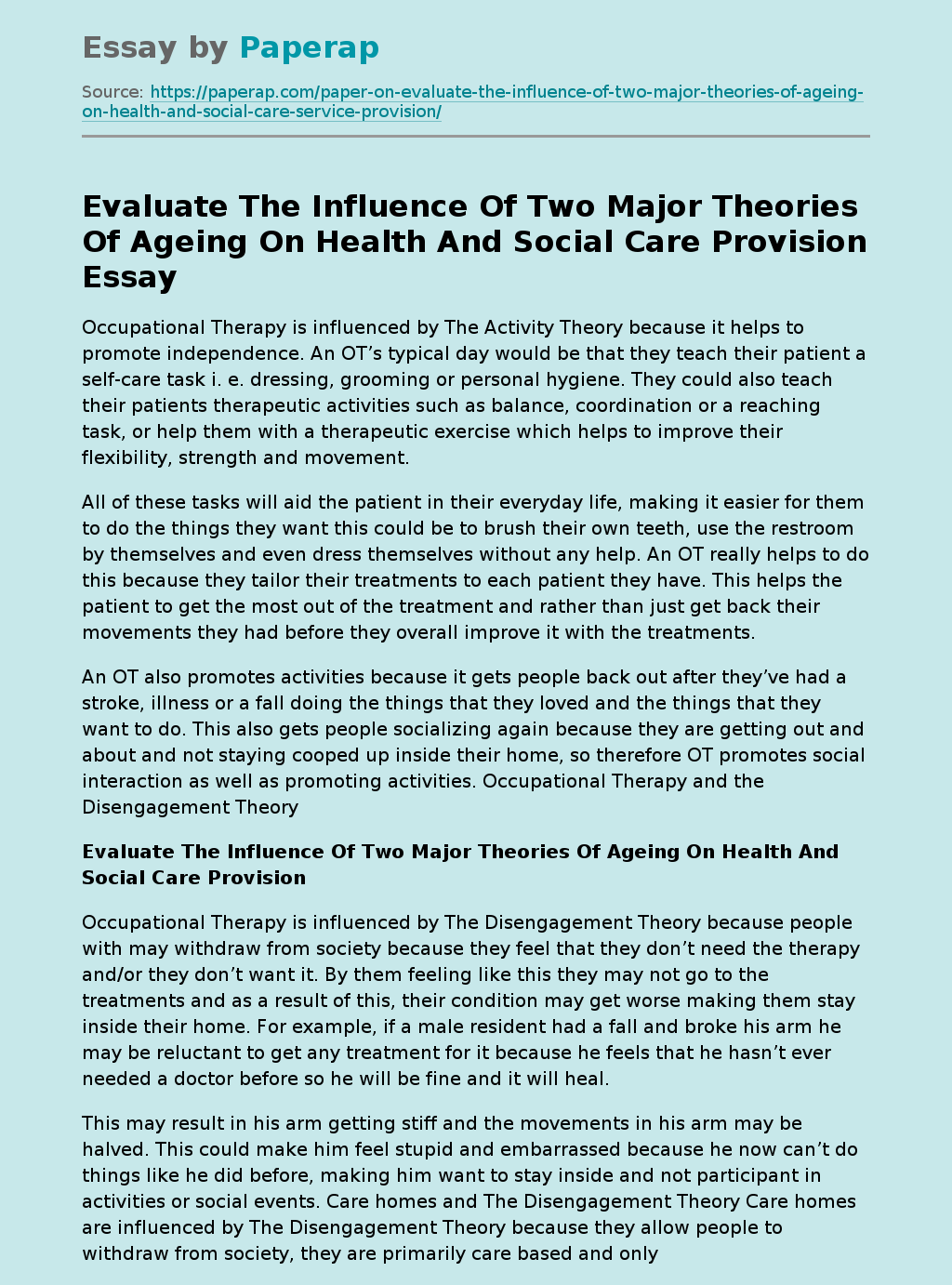Influence of Aging Theories on Health Care?
Occupational Therapy is influenced by The Activity Theory because it helps to promote independence. An OT’s typical day would be that they teach their patient a self-care task i. e. dressing, grooming or personal hygiene. They could also teach their patients therapeutic activities such as balance, coordination or a reaching task, or help them with a therapeutic exercise which helps to improve their flexibility, strength and movement.
All of these tasks will aid the patient in their everyday life, making it easier for them to do the things they want this could be to brush their own teeth, use the restroom by themselves and even dress themselves without any help.
An OT really helps to do this because they tailor their treatments to each patient they have. This helps the patient to get the most out of the treatment and rather than just get back their movements they had before they overall improve it with the treatments.
An OT also promotes activities because it gets people back out after they’ve had a stroke, illness or a fall doing the things that they loved and the things that they want to do.
This also gets people socializing again because they are getting out and about and not staying cooped up inside their home, so therefore OT promotes social interaction as well as promoting activities. Occupational Therapy and the Disengagement Theory
Evaluate The Influence Of Two Major Theories Of Ageing On Health And Social Care Provision
Occupational Therapy is influenced by The Disengagement Theory because people with may withdraw from society because they feel that they don’t need the therapy and/or they don’t want it.
By them feeling like this they may not go to the treatments and as a result of this, their condition may get worse making them stay inside their home. For example, if a male resident had a fall and broke his arm he may be reluctant to get any treatment for it because he feels that he hasn’t ever needed a doctor before so he will be fine and it will heal.
This may result in his arm getting stiff and the movements in his arm may be halved. This could make him feel stupid and embarrassed because he now can’t do things like he did before, making him want to stay inside and not participant in activities or social events. Care homes and The Disengagement Theory Care homes are influenced by The Disengagement Theory because they allow people to withdraw from society, they are primarily care based and only a few activities are put on in the care homes. Some examples of the activities they may put on are bowls and hoops.
These activities may not interest all the residents which may make them stay inside as they can’t be bothered to come down just to watch or the activity may not accommodate for their needs so they may not be able to participate in the activity, this could make the resident feel stupid, embarrassed and lonely as they can’t get involved with the other residents. This in turn could make the resident not want to come out of their apartment at all because they haven’t got involved with anything in the past, they may feel less confident because they don’t know anyone very well.
This may create potential barriers to social interactions between the residents within the care home. Care homes don’t promote independence very well either. This is because they are mainly care givers, however this isn’t all care homes just the majority. They don’t promote independence because they would normally give all the care, such as helping residents get dressed, bathe them, help them to go to the restroom and even help them to eat.
Some residents may like this because it gives them an easy life but some residents won’t have much of a choice because of their health or illness they may have. Care homes and The Activity Theory Care homes are influenced by The Activity Theory because some care homes such as Norah Bellot Court promote activities to get the residents involved and moving which allows the staff members to assess the health and wellbeing of the residents.
Norah Bellot Court is more of a sheltered housing but I’m going to use it as an example. They put on activities such as pool or snooker, bowls, hoops, the WII plus all the games they may have, book days and movie days. You can tell that the residents really like to get involved even when their health or illness does disable them from joining in they still come down to join in and share the company with the other residents.
Influence of Aging Theories on Health Care?. (2019, Dec 05). Retrieved from https://paperap.com/paper-on-evaluate-the-influence-of-two-major-theories-of-ageing-on-health-and-social-care-service-provision/

